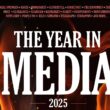Hollywood loves stories about newspapers, so they should go for this one. A Harvard professor lectures on how whole industries have found it impossible to reinvent themselves in the face of technological revolution. He tells newspaper groups they will have to change almost everything in order to survive. Along comes his church (yes) and asks him to save their own 160-year-old daily paper. In a few short years, the professor becomes a media industry hero.
Clark Gilbert (a hint of Superman there) is the mild-mannered professor who had been lecturing on technological “disruption” when he became an adviser to the American Press Institute’s “Newspaper Next” project on a digital future. Few newspapers took his advice. But someone was listening. In 2009, Gilbert’s church came calling and he took control of the Mormon-owned Deseret Media: a chance to put theory into practice.
Four years on, his real-life laboratory experiment has produced dramatic results: strong digital growth but also a bounce-back in newspaper revenues. Everyone wants to know the secret.
It is almost three years since Gilbert cut Deseret News staffing by 43% (85 people) and merged newsrooms with its KSL television and radio stations. It was big news in Utah and also gossip in newspaper boardrooms as the professor studiously avoided any talk of the cross-platform strategies that had long consumed media executives across the world. His 2010 announcement of media revolution in Salt Lake City even came exactly one week after one of the nation’s largest dailies USA Today signed up to “digital first”, the code for ‘managing’ the migration from hard copy.
Instead, the professor was making his case for a new media strategy based on two fundamental points about ‘disruptive innovation’:
- Only 9% of all companies in ‘disrupted’ industries survive. “Let’s be generous and double that: fewer than one in five traditional broadcasters and publishers will survive if historical trends hold”.
- But 100% of that surviving 9% had set up a disruptive (new) business as a totally separate division of the parent company – “no exceptions.” That means a separate location, management, and team – with a significant number of ‘digital native’ recruits and investment to become “the best in the world”. A separate digital company won’t ensure success, Gilbert argues. It is “necessary but not sufficient.”
So, while newspaper executives everywhere were (and mostly still are), developing new digital businesses cheek-by-jowl with their traditional operations, Clark Gilbert is doing the opposite. He believes, quite simply, that the legacy and the digital operations can each thrive only at a distance from each other, literally. He describes it as “dual transformation”.
In addition to Utah’s leading daily newspaper, Deseret Media is KSL-TV, Utah’s leading TV channel, and two radio stations. Just the kind of traditional media business that ought to be hurting. Not a bit of it:
- Deseret News’ weekday and Sunday circulation was up 23% and 10% respectively in the six months to March 31 2013 – while its close rival was -6% and +3%. Its 23m monthly digital page views make it the fastest-growing combined print and online readership (+33% weekday and +90% on Sunday) among American newspapers
- Deseret Digital revenue has grown by an average of 40% for each of the last three years. Page views were up by 50% and unique monthly visitors by 40% in the last 12 months.
- The KSL radio and TV website notched up 200m monthly page views and 3million monthly uniques, making it: the country’s top broadcast site, with two-third of all Salt Lake City adults visiting at least monthly; one of the first to stream radio and TV content; and the first to offer free classifieds – beating Craigslist in Utah.
Gilbert says: “We are not smarter than other people, we just have the conditions where people are working hard and – focused on the legacy business – can actually win. One of the powers of thinking like a disruptive innovator is, if you get structured right, you suddenly look really, really smart even if you are just average—that’s kind of the story of my career. The legacy business is the crocodile, the prehistoric creature that will shrink, but can survive. The digital business is the mammal, the new life form designed to dominate the future. And they need to be managed apart.”
So far so good. But the challenge everywhere else, especially for still-profitable traditional media businesses, lies in the potentially expensive idea of ‘Chinese walls’ between new and old media. But, in a contrarian twist, Gilbert asserts that there must also be a “capabilities exchange” between the two companies: working together without interfering in each other’s operations. In Salt Lake City, an “exchange team” bridges the legacy and digital businesses. And there is also Deseret Connect, a web-based content system that curates stories written by reporters, bloggers and some 3,000 community-based contributors. It provides content for newspaper, online and broadcast. This is one traditional news operation that takes aggregation seriously.
Deseret News is Utah’s oldest daily and, indeed, its oldest surviving business, having been launched within a few years of the establishment there of the Mormon church (the Church of Jesus Christ of Latter-day Saints). ‘Deseret’ (meaning ‘bumblebee’) had been the Mormons’ chosen name for their 19th century state. Now, the legendary newspaper is part of a media empire at the centre of a church with 14m worldwide followers, assets of $30bn and annual business revenues of $5bn from investments in financial services, property – and media.
Its Brigham Young University houses one of the four most popular business schools in the US. The church that earns some $7bn from ‘tithes’ (10% of members’ income) is nothing if not businesslike, a reputation enhanced by its media moves. It was in 2011 – after four years in which US newspapers had lost 50% of their ad revenues – that the respected Pew Research Center’s Project for Excellence in Journalism turned the spotlight on the newspaper-based business that, almost alone, was managing to defy national trends by increasing print circulation as well as digital revenues
Pew identified two key innovations at Deseret News: improved coverage by changing its editorial voice; and separating digital from hard copy. The content changes are, inevitably, easy to miss. But coverage was, crucially, moved away from ‘non-unique’ areas such as style, arts and city politics; and towards ‘issues and topics’, like schools, crime and the search for solutions to community concerns. The paper now focuses heavily on six areas — faith, the family, financial responsibility, education, care for the poor, and values in the media.
Then comes the digital future. In January 2010, the company formed Deseret Digital Media to manage web sites for the legacy operations, Deseret News and KSL broadcasting. Clark Gilbert acknowledges that making money from digital news remains tricky, to say the least. “One of the difficulties is that digital advertising is really hard to grow with plain vanilla banner ads. There are so many other places advertisers can turn, and many are more naturally targeted to specific audiences. So the rates keep falling. But one big success has been KSL marketplace, a classified section that has pre-empted Craigslist locally and now dominates the classified market here.”
The company’s network of digital media sites and services is focused primarily on the Utah market, but is increasingly national and international, not least to a Mormon congregation that is 40% American and has strong concentrations in South America and the AsiaPacific.
The fast-growing digital business now accounts for 25% of the group with broadcast 40% and print 35%. It expects digital to reach 50% within three years. The company’s newspaper-based digital services now account for some 45% of its newspaper revenues, compared with the US average of 17%. The Deseret ambitions are not modest: 10m unique visitors and 1bn page views monthly (producing 4bn ad impressions) by 2015. So Gilbert is aiming high, and banking on growing the geographical reach of his digital media – and on ecommerce for profits.
He is critical of newspaper groups everywhere for persisting with vain attempts to increase the value of news content to match their cost base, rather than facing up to reality: “There never was a great business model for news content. During the good old days of 25 percent margins, expensive news operations were subsidised by newspapers’ quasi-monopoly of the classifieds business, which is now largely dispersed to digital competitors.”
The increasingly-prosperous Utah’s unique position as a state with its own religion (60%+ of the three million residents are Mormons) must give Deseret Media some advantage. And Gallup Poll ‘voted’ it “the best state to live in”. This is a community made for media.
Deseret’s growing revenues from syndicating its content beyond Utah presumably owes much also to its position at the heart of the Mormon church. Clark Gilbert exploits it all: “We want to own faith and the family the way the Washington Post owns politics.” The paper is particularly proud of its ‘War on Boys’ series in February 2012, which examined how young males were losing ground in the public education system, suffering from a lack of male role models and more susceptible to anything from substance abuse to suicide. “I would hold that up against the New York Times or the Washington Post on anything they have done on those kinds of topics,” he says.
It is easy to believe, though, that ownership issues could sometime upset Gilbert’s bold strategy. Deseret successfully operates ancillary web sites and newspapers specifically for the Mormon church. But there is evidence that KSL-TV’s viewing figures have suffered from a surfeit of religious and “values-based” coverage, even while its online services have boomed on the back of breaking news and streamed content. And the whole media project may just become susceptible to the Utah politics of what may be the world’s fastest-growing Christian religion.
Meantime, though, these factors make Deseret an unusual blend of national, local, and even international news media – which, arguably, makes it an even more interesting case study for legacy media groups.
The Harvard professor turned media CEO and president is too much the academic to accept that his company is any kind of special case when it comes to media challenge. And, indeed, the seemingly unique position of Deseret News did not insulate it from the economic downturn experienced by most traditional media companies. Between 2008 and 2010, it suffered a 30% decline in display advertising and a 70% plunge in classified revenues. He attributes the daily’s subsequent recovery to improved relevance and coverage: “Any publication is able to go through the process of uncovering natural advantages and unmet needs in their marketplace. For one newspaper that could mean bolstering coverage of a specific sport or sports team, for another more fully covering an industry that drives the region’s economy. For others, it might be an issue such as the environment depending on the region and interests of people in the market.”
He says: ” Most newspaper companies have focused on the old and missed the new. They’re organised around the newspaper, not around the disruptive business. If we look at online local dollars in our market, we’re getting killed by online-only pure players. Groupon is going to destroy the coupon business in newspapers. These people are stealing all the good parts of the business and leaving you with all the bad parts. The industry is forever broken. Part of the problem I see in the newspaper business is the failure to see the business through the eyes of everyone else,” he says. The industries that are disrupted only see that which is displayed and miss everything that’s new. But newspapers have to rethink the web, not duplicate the paper online. The more your website is like your newspaper, the less likely you are to have high market penetration.”
The four main lessons of the “Deseret experiment” might be summarised as:
- Rebuild your content (and its sources) around what you can do best – and most distinctively. Re-think relevance and engagement with your community.
- Manage digital and legacy businesses separately. Case made.
- Reduce costs commensurate with substantially reduced legacy revenues. A need for tough realism.
- Recruit more leaders from outside media.
Clark Gilbert acknowledges the rising digital success of some US newspaper groups, including The New York Times, whose 16m+ registered digital users make it “one of the only media sources that can let you customize an advertising message around rich contextual context with specific demographic cuts, e.g. male users over fifty reading the sports section. They collect only five categories of consumer demographic data: age, sex, income, geography and e-mail. And yet they have been able to garner 70% premiums for their demographically-targeted advertising.”
One key lesson of digital times is that success can be transient and that long-term market leadership demands continuous improvement, creativity and competitive paranoia on a scale unknown across decades of unchanged print production. So the Deseret “reinvention” can only be the start, as its architect admits: “This is heavy lifting. If you’re not the best at it, people are just going to go somewhere else. That’s just the reality of the web.” But it does clearly demonstrate the way that fresh editorial thinking and aggressive cost savings can breathe new life into hard copy – and enable it to continue to provide the strategic glue for a modern multimedia business. It also seems to prove the importance of the Harvard professor’s ‘Chinese walls’ between new and old.
It has taken an academic and his church to provide the best blueprint so far for the survival of traditional media companies.




Interesting and perhaps implications for the separation out of digitial media from other sections within wider companies?
“Adapt or Die” springs to mind, “attack or defence” one thing is for sure there is no “sitting on the fence” existing knowledge and experience is often resistant to change, time to appoint new specialist
staff or team up with a good digital publishing partner, or both.